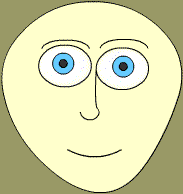Practice Your NLP Eye Access
Acuity
Move your mouse over
the animated face below. As the eyes move,
they access different parts of this person's neurology. Click on the
face or words to start an interactive
exploration of NLP eye-accessing cues and the kind of brain processing
going on in these "neural quadrants." By moving the eyes and
clicking your mouse, you will soon hear phrases that might be processed
using the neural processing pathways in those areas of the brain. Scroll
down and have fun...
Learning about NLP eye
accessing cues and practicing noticing them in yourself and others,
can make your rapport and communications more effective in every area
of your life (business, education, public speaking, personal relationships...)
Be it selling your widget to a customer, influencing a boss or colleague,
communicating with a subordinate or student, or expressing more fully
and clearly with a child or other loved one - this basic NLP skill will
increase the effectiveness of your communications.
(If the eyes do not move as you move your mouse, you
need to download
the Flash 5 plug-in from Macromedia.com.
For more information,
click here. This is a simple and fast download - and well worth
it! Remember the download location of the plug-in Installer file, should
you need to run it to update your browser.)
V K A O G - Visual Audio Kinesthetic Olfactory Gustatory Systems
Early researchers of NeuroLinguistic Programming
noticed that people have experiences of their worlds, which they store
in their brains as visual, auditory, kinesthetic (and olfactory and
gustatory) representations. If you think of a pleasant memory, you can't
help recalling a very specific set of images, sounds, feelings, smells
and taste sensations that represent that specific memory. Each memory
has a specific set of these representations, which is how we can tell
the difference between one memory and an other.
In NLP, we learn that when we access these
V's and A's and K's, we predictably move our eyes in specific, observable
directions, which seem to correspond with the neural pathways in our
brains that process/store these kinds of sensory information.
When we look up, we generally are connecting
with pictures. Moving the eyes down seems to connect us with kinesthetic
sensations, feelings, and our own self-talk. Moving eyes left and right
horizontally at the mid-line of sight seems to invoke our auditory channels.
Check out the interactive eye access cues game
above to learn more of the fascinating subtleties of this eyes-neurology
connection.
Preferred VKAOG Neural Processing Sequence
By being able to notice
the "preferred visual, auditory, kinesthetic sequence" of
processing of the person with whom you wish to communicate, you can
then deliver your communication to that person in "their own language".
When you do this, paying attention to your partner's rhythms, you can enter into "entranment" with them by first pacing their rhythms and patterns, then leading them in the direction you desire. This is the basis of the "art of influence". It's as useful in selling a used car as it is in persuading your child to brush his teeth.
Imagine paying this sort of attention to one's own inner being. It brings a whole new meaning to "healing the inner child".

